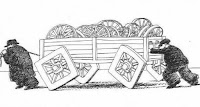Unique project closing of national radio on FM has failed.
Listening figures clearly show less interest for national channels (now exclusively on DAB) than when broadcasting on FM. Local radio continues on FM and many stations now have larger audiences than before the national radio left FM 2017. In the third quarter, many stations increased a lot. Nea Radio is still the country's most popular station with a total of 53% daily coverage in its own area. There are a total of 15 local radio stations that have a daily attendance of at least 16%. - Will still more Norwegians stay on FM and go online rather than turn to DAB? This might be quite a problem of survival for the national broadcasters.
According to PPM survey (week 46) 59.7% listen daily on national radio (the public broadcaster NRK and two commercial networks). NRK continues to dominate with 66.2% national market share against the P4 group (NENT) 22.3% and Bauer Media 10.7%.
Besides the main channels NRK P1 37.1%, NRK P1+ 12% and P4 14.2%, there are no other channels with more than 5% share and eight channels have less than one (1) percent share. Bauer's main channel Radio Norway has only 2.9% of the nationwide radio market, which today comprises a total of 25 channels on DAB. The channels are also online. As in other countries, listening is constantly increasing online, especially with smartphones (which always lack DAB).
According to recent estimates, less than half of the Norwegians listen to radio via DAB. Many select local radio and neighboring radio on FM as well as streaming services for both Spotify etc and national radio. Half of the Norwegian car park and the majority of visiting foreign vehicles do not have DAB installed.
Usage of distribution platforms for radio listening in Norway are apportioned in round numbers (October 2018):
FM 25%
DAB+ 45%
Online 30%
Observing what has been reported during the year on social media, newspapers (reports and debate) shows that the dissatisfaction with the transition from FM to DAB is extensive. The public irritation is particularly high with the lack of coverage which gives signal loss especially when driving. An opinion poll recently also shows that two out of three Norwegians do not experience any improvement with DAB compared to FM.
Many Norwegians have also reacted strongly to being forced upon a system that they never asked for. Irritation becomes particularly evident when it is discovered that Norway is the only country in the world replacing FM with DAB for national broadcasters.
Local radio representatives have told politicians that without FM they will not survive. They want to get the broadcasting licenses extended by ten years to 2031. This may threaten the continued development of the DAB project and special interests in NRK and P4 are reported to fiercely counteract such competition. In particular, the ban prohibiting commercial local radio on FM in the four major cities is defended. However, a continued ban is considered by some observers to counteract both the Norwegian constitution and a free market competition.
In the political parties, support for local radio is increasing and more politicians have announced a possible support of the Center Party’s (Sp) proposal to extend the FM licenses to 2031. The Progress party (Frp) has always been against switching off FM radio and now Conservatives (H) politicians have also expressed their willingness to support the proposal. Now Social Democrats, Sociistisk Venstre, Venstre (Liberals) and Kristeligt folkeparti (Christian democrats) are joining. But still not including FM in the four major cities.
Conservative party district in northern Troms and Finnmark counties now support the proposal in the Storting. The district says that local radios today broadcast mostly on FM, to the greatest satisfaction for the people, especially at the outskirts, where not once DAB can be received. A few local radios have started to work with DAB, and are struggling to get financing for this. So for a long time, FM will be important for reaching the listeners,
especially here in northern Norway. It is also important for national and local security to reach the people in an emergency situation, and FM is still in a special class, as FM is a much more robust system than DAB.
The party district means inter alia: that a shutdown of FM in 2022 will lead to a series of bankruptcies local stations, as they no longer reach people in their concession areas and therefore no longer have any value for local actors. FM is fully established for the local radio, which itself finances this distribution of radio signals. And in the foreseeable future, the frequencies will be available, as most of the world uses this frequency range for FM and is not so dedicated to DAB, says the Troms and Finnmark district.
In the parliamentary committee on culture, Tage Pettersson (conservative) has expressed a positive opinion about an extension of the FM state. The issue is expected to come up in the government's forthcoming media proposition to the parliament 2019.
Conservatives, Progress Party and the Liberals hold the present coalition government with Christian Democrats (KrF) now joining.
Read more
FM er fortsatt viktig for det lokale mediemangfold på Radio (Troms og Finnmark Høyre)
Also read
Parliament Proposal in Norway: FM Radio For Another Ten Years
Norwegian MP: DAB Radio in Norway Is a Tragedy
DAB Radio Questioned by Auditors and Business in German Federal State
DAB Radio Technical Problems

